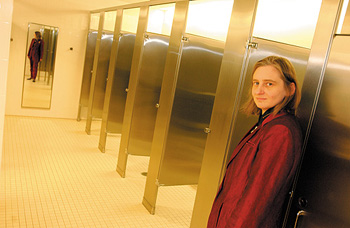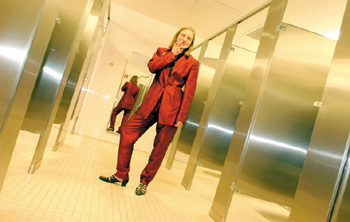Mary Anne Case — Toilet
Inequities
How long do you think this
will take?” Mary Anne Case asks the photographer.
“I hate to take up the biggest, most accessible women’s
restroom during exam week.” It’s a concern that
fits the Law School professor’s ongoing, anecdotal
research: the
toilet survey.
The questionnaire asks patrons of restaurants,
stadiums, and other public places to mark how many stalls
and urinals are in the men’s room and how many stalls
and urinals—if any—are in the ladies’
room. It asks what additional “services” each
offers: mirror, vanity table, chair, fainting couch, attendant,
baby-changing table, nursing or breast-pumping station.
It asks the length of the line.

Lines for public bathrooms, one of the
last supposed vestiges of “separate but equal,”
regularly show the facilities are anything but. “What’s
most often equalized is square footage,” Case says.
But because urinals are smaller than stalls, “men
are almost always offered more excreting opportunities than
women,” which likely accounts for longer women’s
lines—not women simply taking longer. And more of
the space in women’s bathrooms, she notes, is filled
with vanity tables, fainting couches, and baby stations.
The project—after several years
she’s collected hundreds of surveys for a planned
law-review article—was spurred by Case’s research
into the history of constitutional arguments for equal protection
of the sexes. Believing the law rarely should distinguish
between males and females, she advocates “a model
akin to the typical airline toilet,” providing ultimate
privacy without segregation (though she’s learned
that many women prefer a same-sex environment).

The survey also gives men and women
“a sense for how the other half lives,” Case
says. For instance, when she visited a New York children’s
museum, a male companion saw a poster in the boys’
room asking, “Who can ‘go’ faster? It
takes men about 45 seconds to urinate (pee). It takes women
about 79 seconds to urinate. How do you compare to the average?
Ready, Get Set, GO!” No such poster, Case confirmed,
was in the girls’ room.
—A.B.
Select an expert:
Riccardo Levi-Setti - Trilobites
Richard Epstein - Parking
and Property
Mary Anne Case - Toilet
Inequities
Roman Weil - Vintage
Wine
Robert Grant - Sunken Submarines
David Galenson - Poetic
Values
John Milton - Poise
and Noise


![]() Advertising
Advertising
![]() About
the Magazine
About
the Magazine ![]() Alumni
Alumni
![]() UChicago
UChicago
![]()
![]() ©2003 The University
of Chicago® Magazine
©2003 The University
of Chicago® Magazine ![]() 5801 South Ellis Ave., Chicago, IL 60637
5801 South Ellis Ave., Chicago, IL 60637![]() fax: 773/702-0495
fax: 773/702-0495 ![]() uchicago-magazine@uchicago.edu
uchicago-magazine@uchicago.edu
